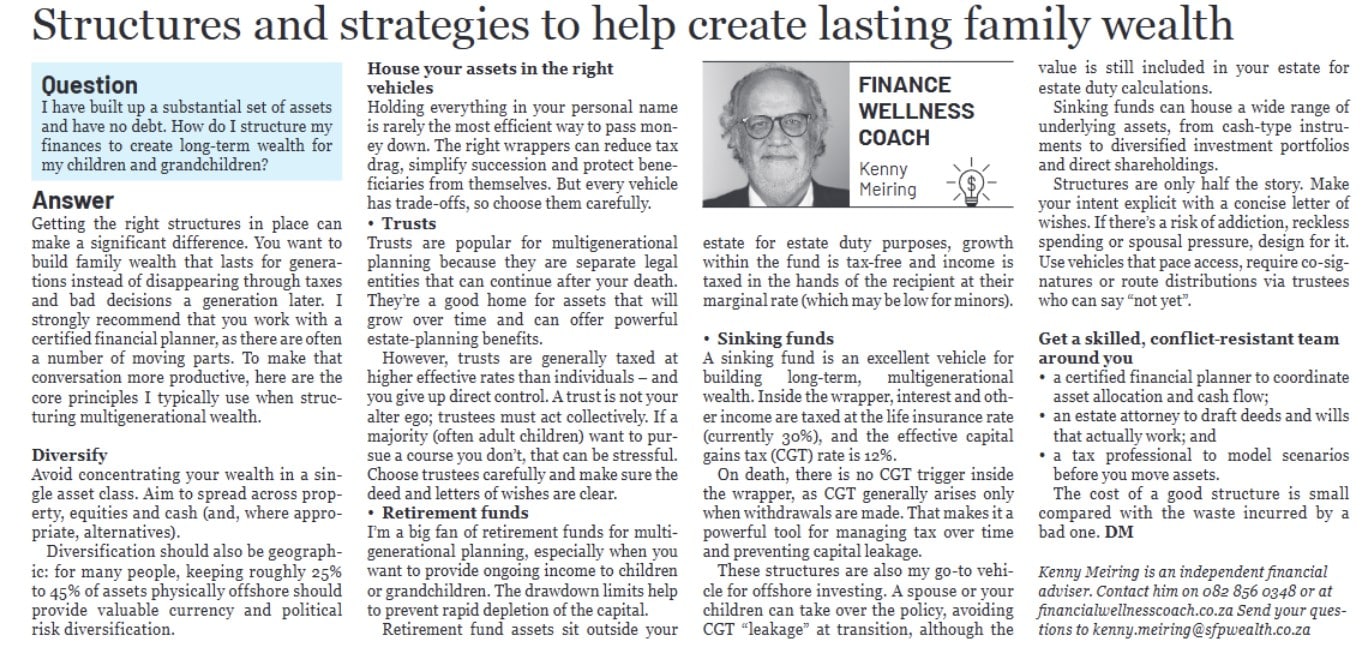No. 222 – Structures and strategies to help create lasting family wealth
Question
I have built up a substantial set of assets and have no debt. How do I structure my finances to create long-term wealth for my children and grandchildren?
Answer
Getting the right structures in place can make a significant difference. You want to build family wealth that lasts for generations instead of disappearing through taxes and bad decisions a generation later. I strongly recommend that you work with a certified financial planner as there are often a number of moving parts. To make that conversation more productive, here are the core principles I typically use when structuring multi-generational wealth.
Diversification
It’s never wise to have all your eggs in one basket. Avoid concentrating your wealth in a single asset class—whether it be listed shares, rental property, or your own business. Aim to spread across property, equities and cash (and, where appropriate, alternatives).
Diversification should also be geographic: for many people, keeping roughly 25%–45% of assets physically offshore should provide valuable currency and political risk diversification.
House your assets in the right vehicles
Holding everything in your personal name is rarely the most efficient way to pass money down. The right wrappers can reduce tax drag, simplify succession and protect beneficiaries from themselves. But every vehicle has trade-offs, so choose them carefully.
- Trusts
Trusts are popular for multi-generational planning because they are separate legal entities that can continue after your death. They’re a good home for assets that will grow over time and can offer powerful estate-planning benefits.
However, trusts are generally taxed at higher effective rates than individuals, and—crucially—you give up direct control. A trust is not your alter ego; trustees must act collectively. If a majority (often adult children) want to pursue a course you don’t, that can be stressful. Choose trustees carefully and make sure the deed and letters of wishes are clear.
- Retirement funds
I’m a big fan of retirement funds for multi-generational planning, especially when you want to provide ongoing income to children or grandchildren. The drawdown limits (2.5%–17.5% a year) help prevent rapid depletion of the capital.
Retirement fund assets sit outside your estate for estate-duty purposes, growth within the fund is tax-free, and income is taxed in the hands of the recipient at their marginal rate (which may be low for minors).
You also retain full control while you’re alive. Under the two-pot system, there is limited access to a “savings” component, subject to the rules, which can provide some liquidity without derailing the long-term plan.
- Sinking funds
A sinking fund is an excellent vehicle for building long-term, multi-generational wealth. Inside the wrapper, interest and other income are taxed at the life-insurance rate (currently 30%), and the effective CGT rate is 12%.
On death, there is no CGT trigger inside the wrapper as CGT generally arises only when withdrawals are made. That makes it a powerful tool for managing tax over time and preventing capital leakage.
These structures are also my go-to vehicle for offshore investing. A spouse or your children can take over the policy, avoiding CGT “leakage” at transition, although the value is still included in your estate for estate-duty calculations.
Sinking funds can house a wide range of underlying assets, from cash-type instruments to diversified investment portfolios and direct shareholdings.
Structures are only half the story. Make your intent explicit with a concise letter of wishes. Draw up a plain-English “family charter” that sets expectations. It is important that heirs learn how money is stewarded, not just that money exists. If there’s a risk of addiction, reckless spending or spousal pressure, design for it. Use vehicles that pace access, require co-signatures, or route distributions via trustees who can say “not yet”.
Get a skilled, conflict-resistant team around you
- a certified financial planner to coordinate asset allocation and cash-flow
- an estate attorney to draft deeds and wills that actually work
- a tax professional to model scenarios before you move assets.
The cost of good structure is small compared with the waste incurred by a bad structure.
KENNY MEIRING IS AN INDEPENDENT FINANCIAL ADVISER
Contact him via phone, email or via contact phone on the financialwellnesscoach.co.za website

Read more of our articles on the Daily Maverick website or newspaper weekly!

